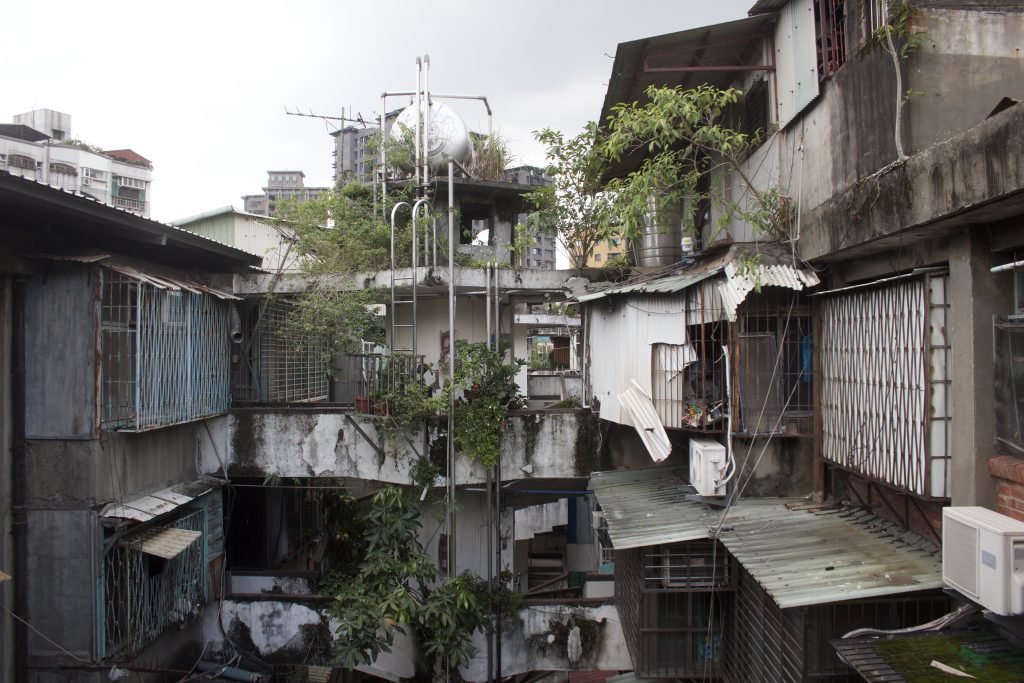文/圖:llegal Taipei「非法台北」 / 譯:YC Shih
「非正式都市學」(informal urbanism)意在形容幾種不同的都市場景,例如貧民窟、一般住宅旁衍伸出自行搭建的住宅,或未受規範自行擴展範圍的街頭小販。這種恣意生長的城市有機體遊走於法律邊緣,反映了急遽擴張的都市化現象,正普遍的發生於全世界。探討原因,不外乎是源自於不符時勢的法規、民眾普遍買不起房以及社會住宅補助的缺乏。(*譯註)
 恣意生長的城市有機體遊走於法律邊緣
恣意生長的城市有機體遊走於法律邊緣
近代對於大都市的定義,通常會琢磨於其中正式與非正式的關係,但糾結於此並無助於探討問題的本質。為了幫助在實際環境中,了解未來都市規劃的趨勢,我們認為有必要去釐清折衷的規劃方法。雖然這些非正規的建築體的發展來自於嚴格的法規中,民眾基於人性的需求找到的出路。但另一方面來說,這種有機體也常常忽略其自身對環境造成的影響,並未考量位處於都市發展中的一環責任,造成一連串負面的社會現象與問題,也是必須要被處理的議題。
llegal Taipei「非法台北」是由來自捷克布拉格的兩位建築師,召集一群藝術與其他專業領域人士所成立的。我們探索台灣城市中的違章建築現象,針對非正式都市學進行非正式的調查。我們不附屬於任何機構,亦不採用既定的方法論,憑著現場直覺所進行的調查,將結果發表在經常更新的 llegal Taipei 「非法台北」部落格以及同名的臉書、instagram等社群網站上。所有的調查的結果與數據,最終希望能出版名為 llegal Taipei《非法台北》的專書,並以捷克文和英文發表。裡頭將清楚的呈現台北城的地景風貌、城中人的大小故事,伴以原汁原味的影像以及獨到的視覺呈現。
 llegal Taipei 「非法台北」部落格
llegal Taipei 「非法台北」部落格
之選擇台北當研究對象,是因為其中一名成員在台北交換學生的那一年,發現到台北違章建築的密集度,有著明顯的地方性格與島嶼城市獨特的歷史發展痕跡。台北的非正規面貌,有著獨特的城市地景,伴隨自主的氛圍以及強烈的城市自明性,在亞洲甚至全球城市下都是特殊的存在。
 台北的非正規面貌,有著獨特的城市地景,伴隨自主的氛圍以及強烈的城市自明性。
台北的非正規面貌,有著獨特的城市地景,伴隨自主的氛圍以及強烈的城市自明性。
為了瞭解更多,今年六月時我們在台北進行為期一個月的田野調查。我們的八人小組針對幾個不同面貌的非正規地景進行調查:
- 頂樓加蓋
- 都市村落、眷村、原住民部落(例如:寶藏巖、Kamaya)
- 夜市
- 不同形式的街道佔用
同時我們也與台北科技大學與政治大學的教授與學生、電影”Life on the Rooftop”導演與其他對此議題有興趣的專業者有所交流。
台北市幾乎每個住宅都做了頂樓加蓋,也讓我們這趟田野調查得以專注在屋頂使用的議題。這個城市中的第二種面貌是建構於小尺度的土法煉鋼建築(鐵皮屋),讓都市披上一層絢麗的馬賽克拼貼,使棋盤式風貌的都會台北,也有了親切的鄉村風味模樣。


 讓都市披上一層絢麗的馬賽克拼貼,使棋盤式風貌的都會台北,也有了親切的鄉村風味模樣
讓都市披上一層絢麗的馬賽克拼貼,使棋盤式風貌的都會台北,也有了親切的鄉村風味模樣
我們拜訪了十幾位違章與頂樓加蓋的屋主,這些可貴的採訪經驗與訪問資料我們也將放入即將出版的專書中。有別於「官方」所塑造整齊劃一的城市,台北的屋頂景觀有如鄉村般的景致,其天台情趣也反映出城市居民對自然環境的嚮往。對比於動輒勞財傷民的城市建設,這些從本地資源發展而成的非常規建築更具親民尺度。
 台北的屋頂景觀有如鄉村般的景致,其天台情趣也反映出城市居民對自然環境的嚮往
台北的屋頂景觀有如鄉村般的景致,其天台情趣也反映出城市居民對自然環境的嚮往
出乎我們意外的是,原先以為這些屋頂人家會排斥與我們交談,但他們其實非常願意分享自身的故事。這些人住在這裡並非因為貧窮或社會弱勢,有些人還是高收入所得。選擇住在屋頂,某些程度上是生活方式的選擇,他們偏好更無拘無束的空間利用,採光良好,還能在居高處眺望城市。在市中心,擁有私人的園藝空間還能邀請朋友聚會,住在屋頂實為划算。就我們看來,其生活品質等同於住在一戶房或是一棟度假小屋。
 選擇住在屋頂,某些程度上是生活方式的選擇,他們偏好更無拘無束的空間利用
選擇住在屋頂,某些程度上是生活方式的選擇,他們偏好更無拘無束的空間利用
於此,我們認為應將這類非常規建築視作一種人類基於根本需要衍發出的創意表現。這種理所當然的對空間的渴望已扎根許久,可說是根深蒂固的傳統;相較之下,「經規劃過的城市」(official city)就顯得像是初來乍到的新手了。
*譯註:“informal”一詞在本文中根據不同語句翻譯成非正式、非正規及非常規,文中在台灣所提及的案例可參考違章建築、頂樓加蓋、鐵皮屋、非列管眷村等不同形式的建築模式。
Illegal Taipei – Informal research on informal architecture and urbanism in Taiwanese metropolis
The informal urbanism describes different urban occasions such as slums or spontaneous houses which parasite on legal dwellings as well as the unrestrained expansion of street vendors. This organic layer of the cities emerges on the edge of illegality, as a result of an overly fast urbanisation throughout the world often due to inadequate planning regulations, the absence of affordable housing and a lack of social housing funds.
The relationship between the informal and the formal is now becoming the definition of modern metropolis. To find a compromise between these two is nothing short of helping us better understand the future of urban planning in our own conditions. The informal structures are at once a mechanisms of human temperament and inspiration to the often overregulated cities of the ‘west’. On the other hand the informal is often ignorant of its surroundings. It does not take the urban whole into the account and generate series of negative phenomena and social problems, which need to be addressed.
We are a group of artists and experts led by two architects from Prague, Czech Republic. We run an informal research of an informal urbanism called Illegal Taipei focused on studying illegal structures in Taiwanese metropolis. Our intuitive research approach is not structured by a formalised methodology nor are we working under any institution yet. In the present time we are operating an active blog entitled Illegal Taipei and a homonymous Facebook page and Instagram profile.
We would like to conclude the series of our activities with a publication entitled Illegal Taipei, which will describe all the data we have gathered. This book, published both in Czech and English language, will be based around a clear disclosure of this urban phenomenon, real stories of people, authentic and attractive photographic material and original graphical format.
We chose the specific case of Taipei, because of our year long study experience there, when we first got in touch with the city and its layer of informal dwellings. We noticed then that the informal form of densification in Taipei has certain specificities, which are caused by local character and historic development of the metropolis and the island itself. Informal Taipei is a distinct urban environment with autonomous atmosphere and strong sense of identity therefore unique in both its Asian, as well as the global context.
Since we wanted to deepen our knowledge, we have organised a month long field trip to Taipei in June 2017. Our eight-member group (equipped with a professional photo technique and a busy schedule) focused on different informal typologies we consider characteristic for Taipei:
- Rooftop housing extensions
- Urban villages, military dependents’ and aboriginal villages (e.g. Treasure Hill, Kamaya)
- Night Markets
- Informal occupation of the street level
We also got into touch with professors and students from National Taipei University of Technology and National Chengchi University, a director of the movie Life on the rooftop and other local experts, who are interested in the same topic as we do to discuss our approach.
The greatest part of our field trip was dedicated to the rooftop problematics. Almost every residential building in the Taipei city is provided with an illegal rooftop extension. This secondary layer of the city formed by small-scale DIY architecture thus covers the modern metropolis with a grainy colourful mosaic, transforming the urban grid of large housing blocks into a rural human scale pattern.
We have made more than ten individual visits of the illegal or informal rooftop households. It was both a great personal experience and a significant resource of knowledge and materials that we are going to use in our upcoming book. The rooftop landscape of Taipei we discovered is a surprising village-like environment with a unique atmosphere contrasting to the “official” city and referring to a natural needs of its inhabitants. In contrast to the megalomaniac projects, the informal structures are built from local resources and have human scale.
The number of interviewees and their willingness to share their stories exceeded our expectations. We thought that the rooftop dwellers are going to be shy and careful to whom they speak, but it was quite the opposite. The people and families don’t live like that because of poverty, they are no edge of the society, on the contrary they often have high incomes. The reasons why do people prefer such kind of housing differ, but it has something to do with the lifestyle and fulfilling the need for free space, light and visual contact with the city. It is also an economic way to live in the city center and a way how to get a personal outside space to grow plants or invite friends over. We see the life on the rooftop basically as an equivalent of living in a family house or a having a holiday countryside cabin. Our conclusion is that Informal architecture is sort of a manifestation of human creativity motivated by basic needs. These natural tendencies have very deep tradition, they are ever present, while the ‘official’ city is a relative newcomer.
來自捷克布拉格的兩位建築師,召集一群藝術與其他專業領域人士所成立的。我們探索台灣城市中的違法建築結構,針對非正式都市學進行非正式的調查。我們不附屬於任何機構,亦不採用既定的方法論,憑著現場直覺所進行的調查,將結果發表在經常更新的 llegal Taipei 「非法台北」部落格以及同名的臉書、instagram等社群網站上。對我們的研究有興趣想支援,或想詢問任何問題,請透過 illegaltaipei@gmail.com 或臉書粉絲頁 Illegal Taipei 與我們聯絡。
譯者/ YC Shih
兼職賣圖與全職賢妻
來自捷克布拉格的兩位建築師,召集一群藝術與其他專業領域人士所成立的。我們探索台灣城市中的違法建築結構,針對非正式都市學進行非正式的調查。我們不附屬於任何機構,亦不採用既定的方法論,憑著現場直覺所進行的調查,將結果發表在經常更新的 llegal Taipei 「非法台北」部落格以及同名的臉書、instagram等社群網站上。對我們的研究有興趣想支援,或想詢問任何問題,請透過 illegaltaipei@gmail.com 或臉書粉絲頁 Illegal Taipei 與我們聯絡。
